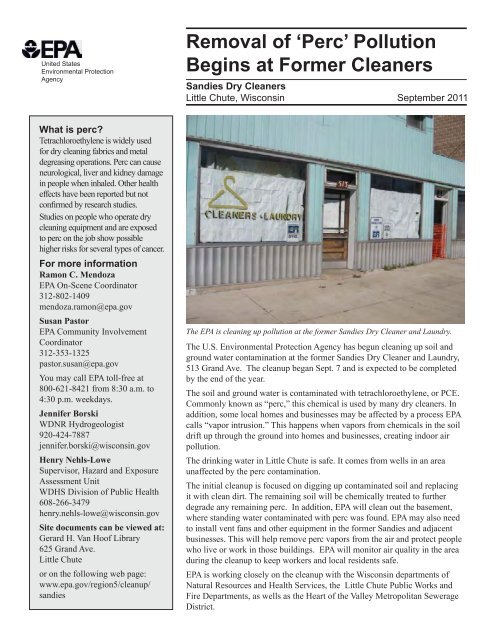'perc' Pollution Begins at Former Cleaners - US Environmental ...
'perc' Pollution Begins at Former Cleaners - US Environmental ...
'perc' Pollution Begins at Former Cleaners - US Environmental ...
Create successful ePaper yourself
Turn your PDF publications into a flip-book with our unique Google optimized e-Paper software.
United St<strong>at</strong>es<br />
<strong>Environmental</strong> Protection<br />
Agency<br />
Wh<strong>at</strong> is perc?<br />
Tetrachloroethylene is widely used<br />
for dry cleaning fabrics and metal<br />
degreasing oper<strong>at</strong>ions. Perc can cause<br />
neurological, liver and kidney damage<br />
in people when inhaled. Other health<br />
effects have been reported but not<br />
confirmed by research studies.<br />
Studies on people who oper<strong>at</strong>e dry<br />
cleaning equipment and are exposed<br />
to perc on the job show possible<br />
higher risks for several types of cancer.<br />
For more inform<strong>at</strong>ion<br />
Ramon C. Mendoza<br />
EPA On-Scene Coordin<strong>at</strong>or<br />
312-802-1409<br />
mendoza.ramon@epa.gov<br />
Susan Pastor<br />
EPA Community Involvement<br />
Coordin<strong>at</strong>or<br />
312-353-1325<br />
pastor.susan@epa.gov<br />
You may call EPA toll-free <strong>at</strong><br />
800-621-8421 from 8:30 a.m. to<br />
4:30 p.m. weekdays.<br />
Jennifer Borski<br />
WDNR Hydrogeologist<br />
920-424-7887<br />
jennifer.borski@wisconsin.gov<br />
Henry Nehls-Lowe<br />
Supervisor, Hazard and Exposure<br />
Assessment Unit<br />
WDHS Division of Public Health<br />
608-266-3479<br />
henry.nehls-lowe@wisconsin.gov<br />
Site documents can be viewed <strong>at</strong>:<br />
Gerard H. Van Hoof Library<br />
625 Grand Ave.<br />
Little Chute<br />
or on the following web page:<br />
www.epa.gov/region5/cleanup/<br />
sandies<br />
Removal of ‘Perc’ <strong>Pollution</strong><br />
<strong>Begins</strong> <strong>at</strong> <strong>Former</strong> <strong>Cleaners</strong><br />
Sandies Dry <strong>Cleaners</strong><br />
Little Chute, Wisconsin September 2011<br />
The EPA is cleaning up pollution <strong>at</strong> the former Sandies Dry Cleaner and Laundry.<br />
The U.S. <strong>Environmental</strong> Protection Agency has begun cleaning up soil and<br />
ground w<strong>at</strong>er contamin<strong>at</strong>ion <strong>at</strong> the former Sandies Dry Cleaner and Laundry,<br />
513 Grand Ave. The cleanup began Sept. 7 and is expected to be completed<br />
by the end of the year.<br />
The soil and ground w<strong>at</strong>er is contamin<strong>at</strong>ed with tetrachloroethylene, or PCE.<br />
Commonly known as “perc,” this chemical is used by many dry cleaners. In<br />
addition, some local homes and businesses may be affected by a process EPA<br />
calls “vapor intrusion.” This happens when vapors from chemicals in the soil<br />
drift up through the ground into homes and businesses, cre<strong>at</strong>ing indoor air<br />
pollution.<br />
The drinking w<strong>at</strong>er in Little Chute is safe. It comes from wells in an area<br />
unaffected by the perc contamin<strong>at</strong>ion.<br />
The initial cleanup is focused on digging up contamin<strong>at</strong>ed soil and replacing<br />
it with clean dirt. The remaining soil will be chemically tre<strong>at</strong>ed to further<br />
degrade any remaining perc. In addition, EPA will clean out the basement,<br />
where standing w<strong>at</strong>er contamin<strong>at</strong>ed with perc was found. EPA may also need<br />
to install vent fans and other equipment in the former Sandies and adjacent<br />
businesses. This will help remove perc vapors from the air and protect people<br />
who live or work in those buildings. EPA will monitor air quality in the area<br />
during the cleanup to keep workers and local residents safe.<br />
EPA is working closely on the cleanup with the Wisconsin departments of<br />
N<strong>at</strong>ural Resources and Health Services, the Little Chute Public Works and<br />
Fire Departments, as wells as the Heart of the Valley Metropolitan Sewerage<br />
District.
Background<br />
Sandies oper<strong>at</strong>ed from 1957 to about<br />
2003, using perc as the primary solvent<br />
in dry cleaning. The site has been<br />
vacant since 2006. Old machinery and<br />
other equipment rel<strong>at</strong>ed to laundry and<br />
dry cleaning oper<strong>at</strong>ions are still in the<br />
building. There is a vacant apartment<br />
in disrepair on the second floor of the<br />
building where the current owner says he<br />
plans to live in the future.<br />
The building is on Grand Avenue, with<br />
a city-owned alley just to the west. The<br />
block is bounded on the south by West<br />
Lincoln Avenue, and on the north by West<br />
Main Street. Two other businesses in the<br />
block share brick walls with the former<br />
dry cleaner, one on the north side and the<br />
other on the south side. Both businesses<br />
are oper<strong>at</strong>ing and both have occupied<br />
residences on the second floor.<br />
An EPA contractor uses a mini-excav<strong>at</strong>or inside the small room <strong>at</strong> Sandies th<strong>at</strong> once<br />
housed the dry cleaning oper<strong>at</strong>ion.<br />
Reproduced on Recycled Paper<br />
SANDIES DRY CLEANERS SITE:<br />
Removal of ‘PERC’ <strong>Pollution</strong> <strong>Begins</strong> <strong>at</strong> <strong>Former</strong> <strong>Cleaners</strong><br />
Chicago, IL 60604-3590<br />
Region 5<br />
Superfund Division (SI-7J)<br />
77 W. Jackson Blvd.<br />
United St<strong>at</strong>es<br />
<strong>Environmental</strong> Protection<br />
Agency

















